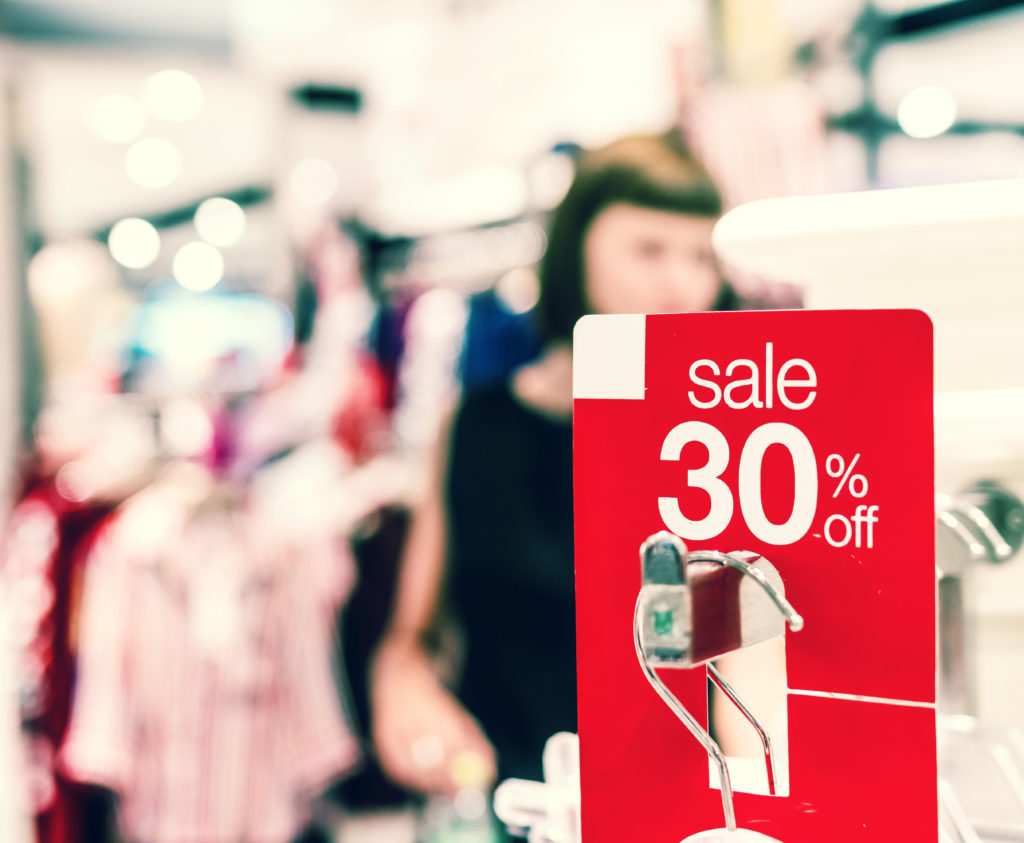
It’s the most wonderful time of the year – you know, that time where you’re continuously bombarded with sales – no matter if you’re strolling through a grocery store, perusing the shops at your local mall, or browsing a site online.
Sales and price promotions are a nearly ubiquitous marketing tool, applied to all manner of products and contexts. And it’s easy to understand why this is the case:
- Intuitively, we know that consumers appreciate a lower price.
- A sale touches on two of the four P’s of marketing strategy: price & promotion.
- The formula seems simple: Lower the price and more customers will purchase a product, and more sales are always better!
However, there is a clear challenge in this tactic. If a lower price encourages more purchases, prices will trend toward zero. The ever-discouraging “race to the bottom.” While it may be easy to increase market share when a product is free, most businesses will eventually expect some profit.
If sales are bounded—and they are for most businesses—what is the optimal discount? Further, is price the only motivation for purchase?
In order to answer these questions, we first need to unpack the consumer psychology behind a sale.
The three types of prices
The first step is to identify what exactly is meant by “price” in the context of sales or discounts. There are 3 important types of prices that contribute to a consumer’s purchase decision (exact terminology may vary depending on the domain and context)
1. Reference Price
The first is often referred to as the reference price. Your customers may or may not have a reference price in mind as they evaluate a product.
For many items, we have a general sense of a reference price, if not a specific one.
When you order coffee in the morning, for example, you might have a strong reference price based on past experience (assuming you’re ordering the same drink at the same shop every morning). Similarly, you might also have a strong reference price when evaluating products you’ve researched extensively, such as cars.
When you grab a bag of apples at the grocery store, however, your reference price may be more vague—something like between $0.75 and $1.25 per pound.
If you spot apples listed at $2.00 per pound, you might feel that the apples are overpriced. If you see apples are listed at $0.25 per pound, the price will likely trigger a feeling that apples are a deal this week.
Reference price is critical for evaluating potential purchases, but it’s important to realize that this price is often the result of incomplete or imperfect information. This means that your customers’ reference price may be wrong or unrealistic.
This error occurs for a number of reasons.

For example, if the last three cups of coffee I purchased were size small, regular, black coffees from a cafeteria, I may form a reference price for coffee that is something like $0.80 to $1.10 per cup. If I go to a Starbucks in an airport and try to purchase a venti latte, thinking of it as just another coffee, the price will seem wildly outside my misapplied reference.
There are a few common techniques to address the challenge of reference prices:
- When giving a discount, always include the original price
- Include one very expensive item of the same class alongside more popular, reasonably priced items
- Reference the price of similar products from more-expensive competitors
- Order items from highest price to lowest (e.g., on a menu board)
- Position price beside another large number (e.g., number of customers served)
2. Reservation Price
The second price is closely related to the reference price, and is commonly known as the reservation price. This is the maximum price that a consumer is willing to pay for a product or service.
If someone has a firmly established reservation price, the reservation and reference prices will likely converge or reach equilibrium. However, the reservation price is influenced by a great number of factors. In other words, consumers are not expected to make a decision based on price alone, but rather on their perception of the overall utility of the purchase.
Utility is driven by a consumer’s budget (the reservation price), expectation (the reference price), and cost (the actual or asking price, discussed next). But utility is also defined by the total value extracted from the purchase. This can be hard to determine because much of this value is not directly observable.
Convenience, desire, craving, and available energy or processing capacity are all factors that may persuade a consumer to accept an asking price above both typical reference and reservation prices. Think about what you’d be willing to pay to rent a stroller after carrying a child around Disney World all day.
For example, convenience, desire, craving, and available energy or processing capacity are all individual factors that may persuade a consumer to accept an asking price that is above both typical reference and reservation prices. Case in point: think about what you’d be willing to pay to rent a stroller after carrying a child around Disney World all day. Or what you’d pay for a bottled water mid-way through a spin class.
Increasing a consumer’s reservation price can be difficult, but some common techniques include:
- Emphasize the quality of the product or service
- Differentiate the product or service with a compelling unique selling or value proposition
- Add value to the purchase with bundled items, features, or services
- Increase expected customer satisfaction with social proof messages
- Increase perceived urgency by making the product scarce or limiting the time a price will be available
3. Asking Price
The third price, as mentioned, is the actual asking price. This is the price that the business demands for the product or service.
Obviously, this is the price that marketing managers have the most control over. However, as discussed, constantly lowering the asking price will eventually lead to a product priced at or below margin, in addition to a number of other undesirable effects on consumer attitudes and behaviors.
The important thing to keep in mind, especially in the context of promotions, is that price is a powerful means of communication with customers.
- A product that is priced below all other competitors sends a signal that it may be cheaper, but it’s likely of lower quality.
- A product that is perennially discounted changes consumer reference prices for the product.
- A utilitarian product that is more expensive than competitors, without a clear unique selling proposition, seems overpriced. Change the selling proposition, however, and the price may suddenly seem reasonable and appropriate.
None of these effects are bad in and of themselves, but they serve as illustrations of the influence price has on consumer perceptions and the importance of setting price and planning promotions with intention.
5 Pricing Perception Tactics to Test
Now that we’re clear on the three different pricing constructs—reference price, reservation price and asking price—there’s an obvious thread through each: perception. Perception is critical to the influence of price on decision-making. So how do you influence the perception of price? Here are 5 pricing perception tactics that you can test on your customers.
Recommended Read: How to make a case for Holiday Testing
1. The Rule of 99
Perhaps the best-known trick for setting prices is the rule of “99.” The simple idea is that a price ending in two nines, as opposed to a rounded dollar value, signals that the item is on sale, discounted or a relative deal compared to competing options. This tactic has been in use for decades and its effect was established in a 1996 study that found 99 pricing produced an 8% increase in revenue for certain catalog retailers.
Ending a price in .99 produced an 8% increase in revenue for certain catalog retailers.
2. Left Digit Bias
Avoiding round prices is not the only means of making prices, or price promotions, easy to interpret. For example, a well-documented phenomenon known as “left digit bias” argues that consumers place undue emphasis on the left-most digit of a price during evaluation. This means that a difference of $5.10 and $4.90 will be perceived to be larger than a difference of $5.80 and $5.10.
3. Absolute vs. Proportional Discounts
A common question is whether price promotions should be presented as an absolute discount (e.g., “$2 off”) or a proportional discount (e.g., “20% off”). The good news is that research has found that both of these messaging approaches help increase sales. However, there is evidence that a proportional discount message may be more effective overall, but absolute discounts may be more persuasive for deal-prone consumers. That there is some disagreement in the research literature on this topic simply means that it is perfect for a test among your customers.
4. Plausible Discount-ability

Providing comparative information is a helpful way to influence perceptions of price, especially for large plausible deals (e.g. “15% off”) and implausible deals (e.g. “Up to 70% off”). Research has found that pairing the promotional price with the regular price (e.g. “Normally $100; Today $50”) increases the performance of these promotions. However, for small plausible deals, providing the regular price seems to diminish the effectiveness of a promotion. Testing, again, is a great way to determine whether your promotions are considered large, small, plausible or implausible.
5. KISS Promotion Pricing
The last psychological process to keep in mind is that of processing fluency. The basic idea of processing fluency is that when it is easy for people to understand and interpret information, it makes them feel good, and leads to subsequent positive evaluations of the object under consideration.
Practically, this means that prices and promotions that are easy to interpret will lead to an increase in positive attitudes toward the product, and likely an increase in purchases. There are a lot of ways to make prices and promotions easier to interpret. Ordering prices such that the lowest are on the left and the highest are on the right makes the series easier to read. Using color or text effects like strikeouts helps facilitate comparisons. Making the important information bigger helps to make it more prominent. All of these ideas, and many more, offer excellent fodder for tests.
Pricing in Practice
Recommended Read: The Expert’s Guide to A/B Testing During the Holiday Season
So, as you head into this crazy period of promotions and sales galore, bask in the knowledge that you’re armed with an understanding of the psychology of a sale and an armful of promotional pricing tactics to influence consumers’ perception.
You can use this knowledge to create a number of theoretically driven tests that tap into the effect of pricing and promotion on consumer decision making. Though the details of each test will vary dramatically, the theories above will help you organize and interpret the results.









